Mark Patricof doesn’t seem like the sort of guy who’d have a magazine with the face of Justin Bieber framed in bubbly shades of orange and pink on the cover sitting on his office coffee table. After all, Patricof is somewhere in early fities; he wears suits; his list of “notable investments” includes companies with names like BetterDoctor and Purchx. He looks like most guys you’d find in a very fancy office on Park Avenue, where the foyer is filled with shiny awards for things like “campaign innovation.”
“I was in Abu Dhabi last fall,” Patricof says, “and there it was on the newsstand. The kids still buy it for the posters. The print piece has kept it alive. I mean, no one’s giving them that sort of shelf space if it’s not selling. So I called them back, and I said we’ll buy it.”

He's talking about Tiger Beat, the 50-year-old teen magazine known more for its abundance of cute teen boys than its journalism that he bought this past summer for $2 million. In 2003, the magazine had been sold to the founder Chuck Laufer’s son, Scott, who vowed to return it to its original teen dream glory. But limited resources and vision allowed the magazine to wither; today, most adults are surprised that it still existed in the first place. Patricof put together a team of investors that include America's Got Talent host and Mariah Carey's ex-husband Nick Cannon, who is also chair of TeenNick; NBA All-Star Kevin Durant; New York Giants chair and media mogul Steve Tisch; Fast and Furious producer Neal Moritz; and Scooter Braun, manager of Justin Bieber, Ariana Grande, and Carly Rae Jepsen — all people who can potentially expand the magazine's base — and kept Editor-in-Chief Leesa Coble, who's been with the magazine since 2001, in her job.
But when we first speak on the phone in early August — after news of the purchase was made public — he is still looking for a CEO. “I want Lena Dunham,” he says. “I have two daughters; I’m very focused on taking some of the fluff out of this thing. I see that you hung out with her. Can you just float the idea?”

Patricof’s pitch for a Dunham-led Tiger Beat, even as Dunham ramps up for the launch of her own newsletter, suggests that Patricof knows what should, theoretically, work for the brand. But that doesn’t mean that it will. "We have every piece we need,” he told me. “And if we screw it up, we'll really feel stupid. But look, you can't tell kids something is cool. No one’s really been able to reach teen girls,” Patricof says. “My kids are addicted to Snapchat, but it’s a tool.”
And aside from Rookie, he’s not wrong. The way we use the internet, and the way teens use the internet in particular, is moving away from websites and homepages and toward content discoverable on various “tools” — whether Snapchat, Tumblr, Instagram, Vine, Twitter, or whatever’s next.
Tiger Beat plans to use all those tools, but it’s also remaining defiantly analog. Unlike other reboots of legacy publications (think Newsweek), the magazine itself — the actual, tangible, print magazine — will remain central. Because the one thing digital culture still hasn’t mastered is the production of the physical, fetishizable, tangible object. Which is precisely what Patricof is betting on: "Once you've made a connection with a magazine, it's a lifelong connection,” he says. “And you want people rooting for you. No one's rooting for [Tiger Beat’s competitors] Twist or J-14. Twist goes away and no one cares. This thing, people care about.” But do they?

Tiger Beat emerged amid a markedly different pop landscape, designed to exploit a teen demographic that, even in 1965, still evaded most marketers. But Charles “Chuck” Laufer learned about teens the easy way: by teaching high school in Beverly Hills. In 1955, Laufer, then 31, was fielding complaints from his female students that they had nothing fun to read. So he decided to fill that void himself, crafting a magazine — first called Coaster and swiftly renamed Teen — replete with details about the things he thought girls wanted to read about. Specifically: the array of teen idols that were emerging from film, television, and music to cater to a generation whose tastes were radically different than their parents’.
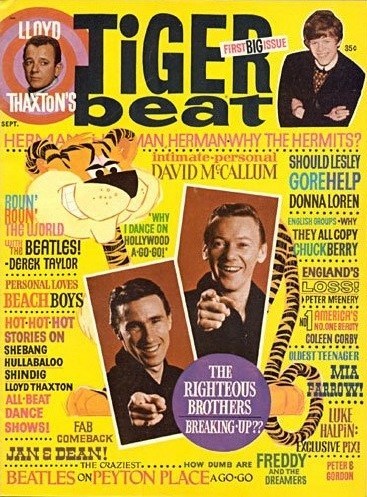
Laufer taught journalism and English, but he had no skill for the business side of publishing, and sold the struggling Teen in 1957. But he kept his eye on the industry, and seven years later, published a Beatles “one-shot” (a one-off magazine packed with pictures and trivia) that sold 750,000 copies in two days. He’d also been observing the state of the once-powerful fan magazines, which had built their names and circulation by working in close symbiotic relationship with the studios. The studios provided them with the raw material for stardom — endless glamour shots of their young talent, intimate interviews, confessional first-person stories — and the slew of Hollywood fan magazines spread the word.
The collapse of the studio system in the ‘50s would fundamentally alter the fan magazine’s modus operandi — and precipitate its slow death over the next three decades. And even as magazines attempted to grasp at the expanding teen audience by playing up teen television hotties like Ricky Nelson, their names (Photoplay, Screenland, Motion Picture, Modern Screen) became firmly associated with a) old Hollywood, and b) moms — anathema to teens obsessed with the new and the cool.
Enter Tiger Beat. “Tiger” was slang for “cute boy”; “beat” indicated how central music — the ‘60s teen medium of choice — would be to the magazine. And unlike the fan mags broadcasting Liz Taylor and Richard Burton’s latest romp, Tiger Beat kept its content strictly PG — there was never a hint of scandal or smut, just dreams of holding hands. The magazine was unabashed in its embrace of the teen audience and their sensibility: Every headline, even the most banal, ended with a flourish of punctuation, such as “David ordered a steak!”
Laufer also honed in on what he’d come to call “the look.” When he first launched in the magazine in 1965, he just put whoever was on the top of the Billboard charts on the cover. But Laufer quickly figured out that top of the charts wasn’t the same as who readers wanted to stare at. They’d put Paul Revere and the Raiders on the cover, but the fan letters that poured in weren’t for Revere, but for lead singer Mark Lindsay. With his plaintive face and big eyes, Lindsay had “the look” — not sexually threatening, cute, but not overly so, and feminine. “They all look like pretty girls,” Laufer told the New York Times in 1972.
Still, Laufer’s real genius was to collaborate closely with the source of stardom itself. He might never get actual access to the Beatles, but he could find his own potential stars — such as Davy Jones of the Monkees, whom he saw in a preview for the first episode of their namesake show and slapped on the cover of the magazine — nail a promotional deal with their publicity team, and, via constant coverage, transform a teen boy into a veritable teen idol. And when you make that idol yourself, your content stream is nearly unlimited, and easily spread across multiple spin-off titles, like Fave, essentially a repackaged Tiger Beat, and Right On!, which was marketed toward black audiences.
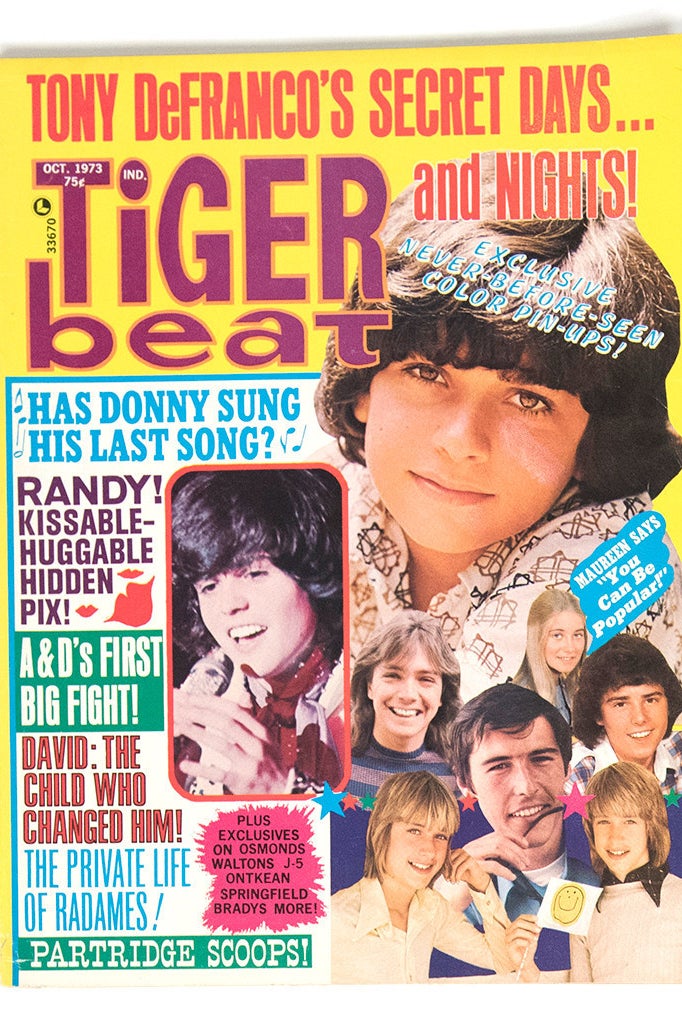

When it became clear that Partridge Family star David Cassidy was the hot new thing, Laufer partnered with the show’s production company to ensure a steady, and mutually beneficial, stream of publicity. When Cassidy’s appeal began to wane, Laufer opted to make his own stars. When a group of siblings from rural Ontario sent Tiger Beat their picture, he dubbed them “The DeFranco Family” and put 13-year-old Tony, who had “the look,” all over the magazine, effectively launching them to stardom. Laufer had turned himself into the classic Hollywood studio and the fan magazine: the best of both worlds.
Laufer also understood the profitability of these magazines wasn’t in subscriptions ($5 for a year) or ads. Instead, it was exploiting the depths of obsession via a vast web of what we’d call “swag”: Each magazine was chock full of offers for fan clubs ($3 for David Cassidy), offers for readers to complete their Tiger Beat collections through the purchase of back issues (75 cents a piece), an “Osmond Sweatshirt ($5) and “Donny Cap” ($5), the Tiger Beat Super Annual ($1.25), the “Star Address Book” ($1.25), selections from the Tiger Beat Paperback Library ($1 a piece for titles like The Secret Lives of Girl Stars, Brady Bunch in New York Mystery, and Stars & Their Pets), and “An Osmond Love Gift” ($2).
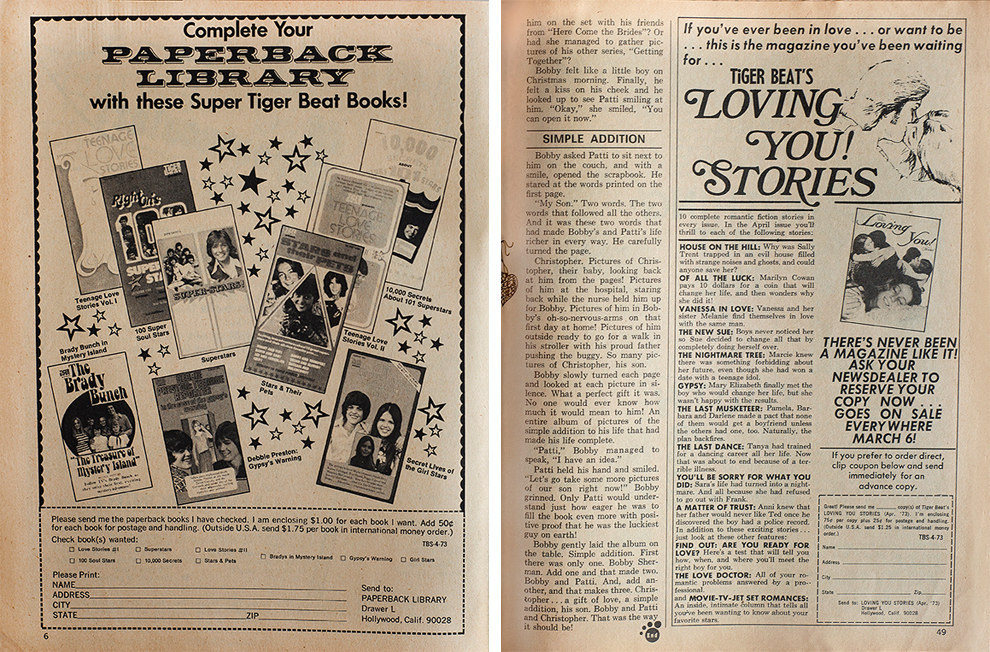
Those handfuls of crumpled dollar bills sent through the mail became hundreds of thousands of dollars, and in 1978, Laufer sold the magazine for a reported $15 million, with circulation cresting at 800,000. Over the next 30 years, the magazine changed hands multiple times before landing with Patricof’s groups of investors. Still, Patricof’s visions of expansion are strikingly similar to Laufer’s, just 40 years updated: It’s all about the swag and brand expansion. When Ariana Grande plays two shows in New York in late September, the magazine will host an “Ariana-inspired pop-up lounge,” with a photobooth that puts fans on Tiger Beat covers. Marketers are scheming for branded opportunities with all manner of entertainment and music producers. The faces and fashions may have changed, but the desire to own part of the aura of your crush remains constant.
There's a story that Mark Patricof likes to tell about the time he was in St. Barts with Nicole Richie and Jessica Alba — "I swear this isn't name-dropping; I've been friends with them a long time" — and their husbands. "One night, I feel my phone buzzing too much. And there’s 15 different texts, saying, ‘You’re in Us Magazine.’ Now all weekend, Jessica had been saying, ‘I don’t want to go to that restaurant, there’s too much paparazzi, I want to go to this other restaurant.’ That’s bullshit, because there’s these pictures right where we went — she tipped them all off! These magazines know what they’re doing.”
It’s Patricof’s way of illustrating his understanding of the celebrity industrial complex. “I’ve been around the entertainment business a long time,” he says. “I know how to navigate Hollywood flawlessly. And most people don’t. I don’t make mistakes. I know the publicists. I did my work before I bought the thing and put it together.”
So Tiger Beat can be a magazine that deftly navigates this world — which isn’t to say it'll start buying paparazzi photography. Rather, it'll maintain what Coble terms “very strong relationships” with Disney and Nickelodeon — and now Scooter Braun — which give the magazine access to stars (photos, interviews, public appearances). Tiger Beat then underlines the strains of those stars’ images that Disney, Nickelodeon, or Braun would like underlined.
“We’re on the same page,” Coble tells me when I visit the magazine’s temporary working space, sandwiched inside the offices of a hip West Hollywood production company. Coble, who started as an intern with the magazine in 2001, has short, bleach-blonde hair, the voice of an enthusiastic camp counselor, and an ageless look; in the photos of her with various teen idols that accompany her monthly editor’s letter, she passes for approximately the same age. “We have the same idea of promoting those people,” Coble explains. “We all have the same objective in mind. That’s how I feel about the investors: Everyone has the same objective.”

It’s an arrangement that recalls not only classic Hollywood, but also Laufer’s original strategy with the magazine. And while the magazine’s relationships with Nickelodeon and Disney have been cultivated for years, Patricof also has his star investors, a film producer brother, another brother who runs the Tribeca Film Festival, and his star friends, all of whom expand and fortify the magazine’s potential collaborations: “We have Durant,” Patricof explains, “so we might do things that are more male-oriented, or more urban-oriented.” It’s easy to imagine a future cover introducing one of Braun’s new finds — and, as such, equally easy to understand why Braun, whose website positions him as a mini–star-production company unto itself, was eager to invest.
Because while the the specific faces on the cover of Tiger Beat have changed — their hair gets longer, then shorter, then shaggier — the underlying ethos of teen idoldom, and the purpose of the magazine, have remained constant. Then as now, the magazine provides an outlet toward which young girls (and boys) can funnel their often overwhelming feelings of desire. It’s not sexual desire, at least not exactly — it’s obsession, the need to want something, to think about it constantly, to feel deeply. Tiger Beat not only validates those feelings, but also gives them shape — often in the form of a teen boy’s angelic face.
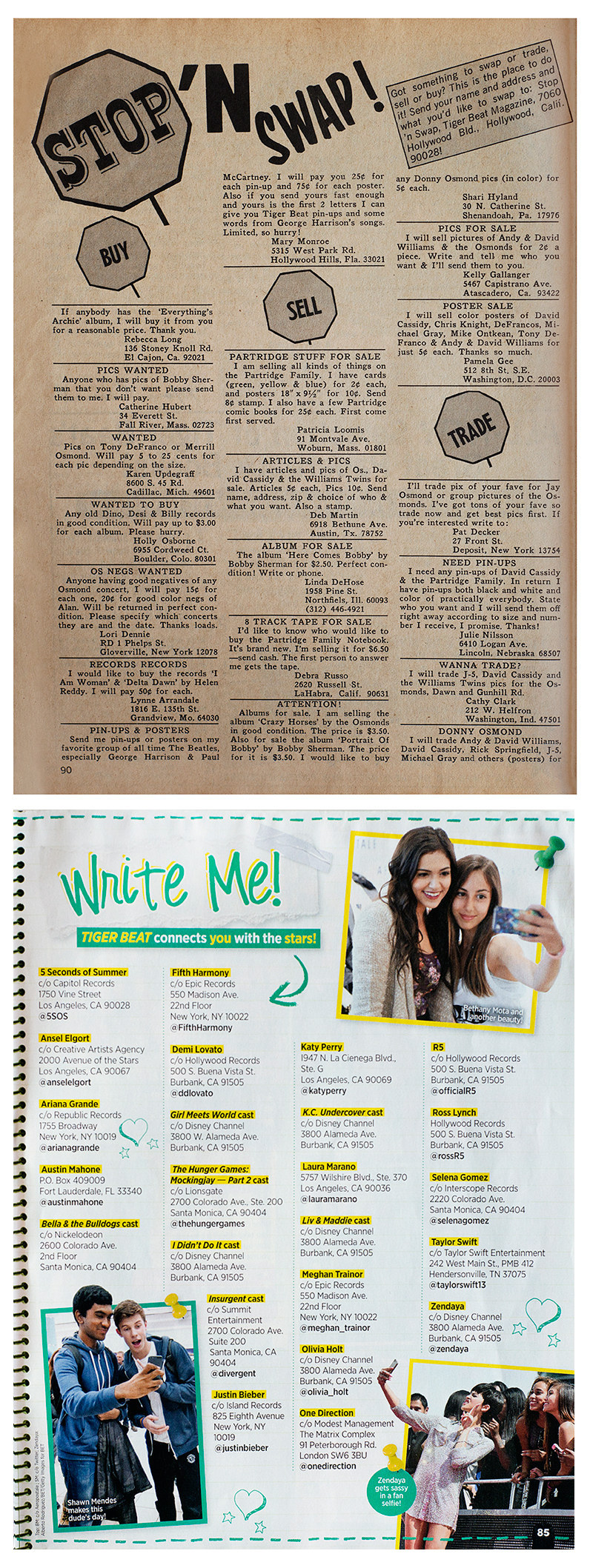
It makes sense, then, that today’s magazine is filled with many of the same essential elements from the Chuck Laufer era: answers to readers questions from stars (The Brady Bunch’s Maureen McCormick in 1972; The Disney Channel’s Olivia Holt today); features dispelling or confirming rumored romances; glam shots of boys looking dreamily off camera (Tony DeFranco then, Vine star Nash Grier now). Gone are the back pages in which readers offer up their home addresses (!) and phone numbers (!!) in order to exchange memorabilia, but quaint analog features — including a page offering the mailing addresses of all the stars featured in the magazines — remain. The tone is still strictly PG (“Hell” is transcribed as “H*ll”) and the exclamation point rules supreme (“Ross’ Super Secret Side!”).
But for all its consistency in content, Tiger Beat’s popularity has wavered. “The thing about the teen magazine industry,” Patricof explains, “is that it’s entirely dependent on there being a star.” (See: JTT in the mid-‘90s, NSYNC and Backstreet Boys in the late ‘90s, the Jonas Brothers in the mid-2000s, One Direction in the 2010s). “And there’s no big star right now,” he continues. “No big male star. The reason I got to buy this thing when I did was because there hadn’t been a star for awhile, and it could just double. It’ll come back, if you stay in business long enough.”
And while Patricof opts not to share current circulation numbers, the $2 million price tag suggests that they weren’t just low, but nearly fatal. The magazine doesn’t even figure as competition to Seventeen (circulation 2 million; 4 million Facebook fans), Teen Vogue (1 million subscribers; 4.9 million Facebook fans). And while the Bauer Group of teen mags (J-14, M, Twist), has a paltry combined circulation of 340,000, its social media presence is a marvel: 5.4 million Facebook fans for J-14, 3.3 for M, 3.2 for Twist. In contrast, Tiger Beat’s barely a blip. Former reporters in the teen mag space told me that they never saw Tiger Beat reporters on the red carpet of A-list teen events, and, until recently, the magazine had an embarrassingly small social media presence — only in the last few years has it built its Facebook following to a respectable 2.3 million. Talking with Coble, it seems clear that the vision for expansion was there, but the resources weren’t forthcoming.
But this is a new Tiger Beat: “Look at my first two hires,” Patricof tells me. “I hired a social media marketing person and then a 27-year-old editor from Real Simple. All I need now is a CEO.” But if not Dunham, will it still be a woman? “It should be. They’re less dramatic, less emotional. It’s totally true.”
They premiered the first redesigned issue and more original content on Snapchat, but its Instagram presence has disappeared — an old account is now occupied by a woman posting tiger photos, and its Tumblr hasn’t been used in a year. Much of this is in the works — Patricof and his team are still hiring; their small team is still in temporary offices — but at this point, it’s not yet in action.
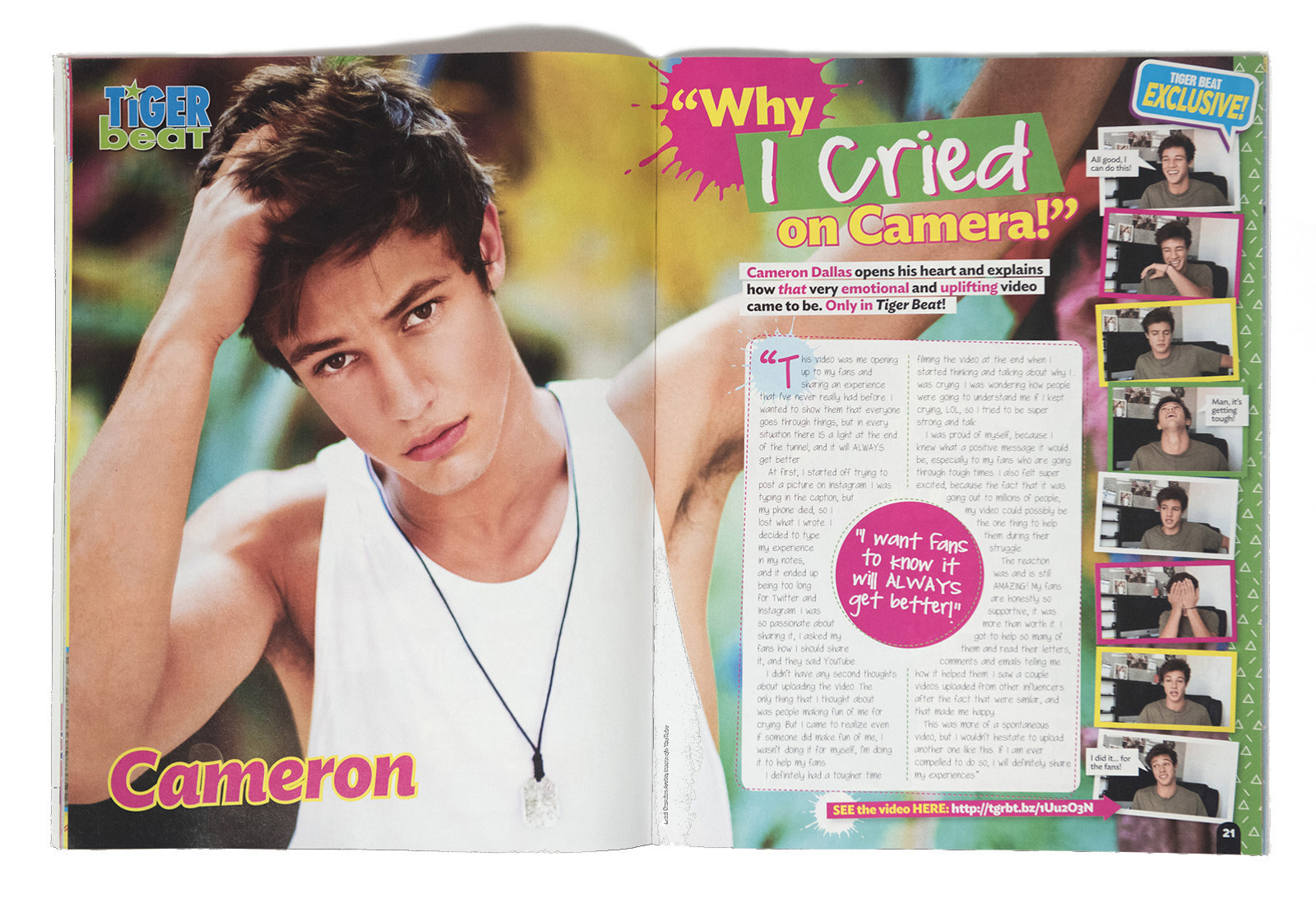
Some of the visions for the magazine seem standard magazine rebranding: Patricof talks about how he wants the magazine to “age up” (less tween, more teen) and play around with the format, the aesthetic, the tone. More compellingly, Coble emphasizes how Instagram has fundamentally expanded the brand’s palette: “Before, we never would have black-and-white photo in the magazine; today, we would. There’s always a tendency to say the age group is cooler and savvier, but in this case, their exposure to Instagram has changed things — the desire to be challenged on an aesthetic level is so much greater now.”
Yet the October issue has only one substantive change. Instead of the cornucopia of dewy faces that have long been Tiger Beat’s trademark, there’s just one: Justin Bieber’s. The same Bieber whose manager is an investor in Tiger Beat.
Perhaps that explains why Braun’s name wasn’t included in the initial announcement of investors (and made public only weeks afterward by “sources” in The Hollywood Reporter). But those optics matter less than whether or not teens will actually buy the magazine: At this point, Patricof says that 95% of its sales are on the newsstand, and if girls don’t see what they want — or think Bieber’s too gross, or too old, or too uncool — then the issue will flop.
The picture of Bieber is classic teen dream, feminine and soft, his tattoos covered, and only the faintest hint of his I’m-an-adult crustache visible. In the “exclusive interview” inside, titled “The Prince of Pop Returns!” he’s nothing but conciliatory toward his fans.“‘There are some things I’ve done in the last couple of years that I’m not proud of,” he admits. “But it was all part of my journey and made me the person I am today,” going on to assure his Beliebers that “you give me light and purpose.” On the Friday before the issue hit newsstands, Bieber tweeted an image of the cover, telling fans “Jb loves the kids. Lol. Honored to find out I’m the first solo @TigerBeatNow cover ever.” The tweet was retweeted more 45,000 times, with fan response of “I’ll buy it just because you’re on it” and “I’m not a kid but I’ll probably buy this.”
Inside the magazine, you can see other subtle signs of change: In the editor’s note, Coble urges readers to email her about “what you think about us having only ONE PERSON on the cover of the magazine. Does it look cool or do you miss seeing a lot of people on the cover? Write me, like, right this very minute.” And just before the prime Tiger Beat real estate (the posters, duh) there’s a page devoted to inviting readers to follow Tiger Beat on Snapchat by “snapping” the image in front of them.
Despite the signs of the magazine's evolution, both Patricof and Coble refer to their audience as “girls”; both had to be prompted to consider the possibility of queer audiences. And while the new Tiger Beat boasts more diversity than its 1970s predecessor, highlighting the racially mixed girl group Fifth Harmony and an interview with Karan Brar about his Sikh faith and his experience as the first Indian series regular on Disney, the magazine is dedicated to following the trends of the industry. “We have an all-inclusive policy of who we cover, but we’re also going with the stars who are the most popular,” Cobble says. “We definitely have room to introduce people, but we’re built on mega-fame. It’s the people who are coming to us.” It’s a nice way of saying that they follow industry trends: If a teen idol of color is in, obviously they’ll feature him; they just won’t lead the way in bringing him to that point. They’re not tastemakers, and don’t covet that role.
As for coverage of queerness or feminism, Coble says that the magazine “isn’t going to get into the political side.” They’ll tweet a link to a speech by Girl Meets World star Rowan Blanchard about the importance of gender equality, but they won’t necessarily feature it in the magazine. At least that’s been the policy to this point. “It may not be a topic that we handle,” Coble says. “Or it may be, I don’t know.” A week after our interview, Coble emails to clarify her statements: “We’re going to cover people as they are. We aren’t going to hide anybody’s sexuality, as teen magazines may have in the past. But we are certainly not going to out anybody or delve into people’s sex lives, since that’s not what we do at Tiger Beat. And, honestly, Tyler Oakley and Troye Sivan are hotties, whether they are gay or straight. Our general message is positivity to and for everyone, regardless of their sexuality. And if someone has a story they want to tell through the magazine, we will tell it.”
And Patricof knows that feminism is, at least for the moment, cool. “I’d like for it to have a voice, and I do believe that the audience goes to the level you publish” — which is part of why he wanted Dunham to serve as CEO. “I don’t know that there’s going to be feminist articles; that’s not why [Tiger Beat] exists,” Patricof says. “I do know that boys are dumb, and girls are crafty — they’re crafty because their hearts and their spirit and their intellect and their bodies don't sync up. Everything's firing. But if you can create a platform that's speaking directly to them, not down to them, but directly to them, and make it fun, you can create that loyalty and you can keep it for a long time.”
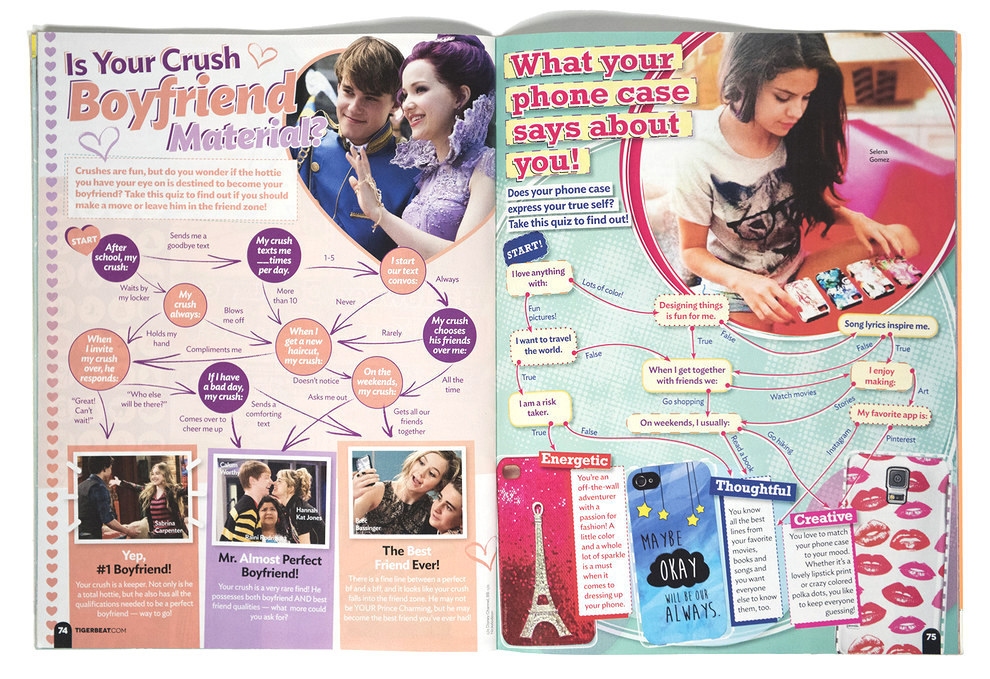
Tiger Beat has never been aspired to be Sassy, or Bitch, or Rookie. But there is space for a magazine that feeds on primal teen emotions to appeal to serve other, progressive functions — to acknowledge that it doesn’t simply reflect teen desires, but helps determines them. Seventeen has done so for 60 years; its brand remains not only evocative, but influential. And while the gender makeup of Tiger Beat’s investors (100% male) is only slightly more skewed than the venture capital world at large, it nonetheless betrays a disconcerting attitude toward the regulation of teen girl desire. Namely, that it’s something that adult men can profit from. When asked about the lack of female investors, Patricof admits, “I didn’t really try with any. You name someone I missed. Seriously, who do you think? If Lena would’ve put in 50 grand, that would’ve been great. But I don’t know who else. I’m not being defensive about it. I just don’t know who else. If you have a great idea, email me.”
But Patricof is, in many ways, just the voice behind the money. Like his father, Alan — who co-founded New York Magazine in 1967 and turned around Details in 1987 — he’s the “business” in the magazine business. “I don’t know what role Tiger Beat plays yet,” he says. “I don’t yet understand the psyche of the demographic.” But he understands enough to keep Coble, and her keen understanding of that demo, at the helm of the magazine, even as he poaches a bevy of young social media specialists and designers to bring the magazine into the future.
It’s Coble, after all, who’s spent the last two decades reading thousands of emails and actual letters from young readers about their affections. Coble’s desk is covered with letters postmarked from Kentucky and Louisiana, addressed with the same rounded, purple penmanship with which I addressed letters 20 years before.
And even though her editor’s letters overflow with exclamation marks and “like right nows,” she’s incredibly perceptive, and understands, in a way that few new to the genre can, just how unchanged the fundamentals of desire remain. “There will always be the experience of a 13-year-old girl coming to her own and developing nonsexual feelings towards boys,” she tells me over coffee across the street from the temporary offices. “Tiger Beat is such a safe, nonthreatening way to do it. There’s an attachment to the boys, of course, but there’s also a feeling of having possession of your own desires and your own interests and feeling like this is the time you get to make some decisions in your life. Granted, they’re not the grandest decision about your future, but they are deciding who you’re into and who you like.”
That declaring yourself in love with one member of New Kids on the Block in 1990, NSYNC in 1998, or One Direction in 2011, in truth, a cloaked declaration of self — and a way of finding others who value the same things as you. There’s an argument that girls should define themselves more in terms of who they like, and an even stronger argument against men commodifying and profiting from the process. The communities of fandom that spring from the magazine might ostensibly center on 1D or R5, but they’re just offering a space — and vocabulary — to articulate larger, more nebulous, and yet all the more essential languages of burgeoning sexuality, communality, and empathy.
These days, teens have so many active and empowering ways to articulate and manifest their identities. But there’s something incredibly pleasurable about the passive experience that accompanies leafing through a magazine and allowing the blank, vague smiles on the faces before you morph into those of true love. Laufer understood as much; it seems Coble does as well, and will attempt to preserve that core dynamic, even as the brand expands into six-second Vines and self-destructing snaps.
Tiger Beat’s success in the ‘60s — and enduring appeal — declared that there’s something different about teen desire. It may not be sexual in the way adults conceive of the word, but it’s just as powerful. Indeed, the alienation that adults feel when leafing through the magazine and encountering foreign names isn’t weird — it’s the point. Teens have to share so much in the world; the beautiful boys and girls that fill the pages are theirs and theirs alone.
Of course, teens can carve out space for those idols, and their desire for them, on the internet — and Tiger Beat wants to help structure that process. But until our walls become digital screens, teens will still need a source from which to carefully cut images of the things that matter to them, even if only for the week or month to come. “You can’t rip apart your tablet or your phone,” says Coble. “With the magazine, you want to physically hear that rip when you tear the poster out of the middle of the magazine, and figure out that perfect spot in the middle of your wall where you can plaster it. And then you want to look at it every night before you go to bed.”

